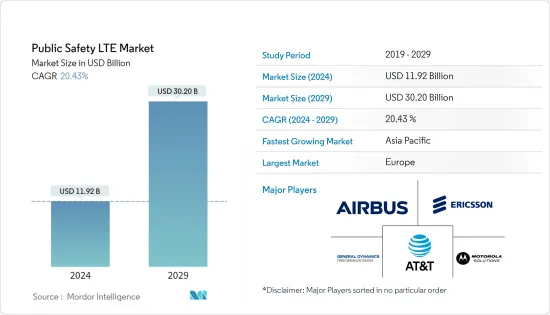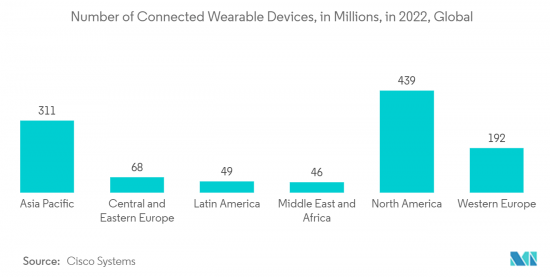PUBLISHER: Mordor Intelligence | PRODUCT CODE: 1404557

PUBLISHER: Mordor Intelligence | PRODUCT CODE: 1404557
Public Safety LTE - Market Share Analysis, Industry Trends & Statistics, Growth Forecasts 2024 - 2029

The Public Safety LTE Market size is estimated at USD 11.92 billion in 2024, and is expected to reach USD 30.20 billion by 2029, growing at a CAGR of 20.43% during the forecast period (2024-2029).
Key Highlights
- Organizations for public safety, including firefighters and law enforcement, among others, are responsible for protecting people in emergencies from natural emergencies. These first responders can work effectively only with flawless communication between themselves to access and share critical information.
- Proximity services enablement is expected to drive the Public Safety LTE Market. Proximity services comprise special features explicitly utilized in the public safety spectrum for public safety applications. One such feature includes one mobile device acting as a relay for another and offering access to the network services outside the normal network coverage area.
- The LTE network for public safety is deployed under mobile broadband standards and enabled with all technological advances incorporated in the cellular network. It allows high-rate-data transfer, which is absent in the traditional Land Mobile Radio (LRM). Currently, the LTE network can transfer up to 75 Mbps on the uplink and 300 Mbps on the downlink. It may increase further with the decrease in the connectivity issue.
- This saves network resources and allows public safety communication in areas outside the network's coverage. Proximity services fulfill the communication need among public safety users in spite of not being in the network coverage. This, in turn, boosts the Public Safety LTE Market. In addition, seamless connectivity and higher speed offered by public safety LTE technology will likely drive the market over the predicted years.
- Also, growing demand for unmanned operations, eliminating network connectivity issues, and remote surveillance facilities are expected to boost the market in the coming years. Additionally, government initiatives like smart city development, increasing penetration of the Internet of Things, and increasing threats of natural disasters and crimes are expected to fuel the market during the forecasted years.
- Factors such as costly infrastructure, issues associated with allocating spectrums, and reliability concerns can act as market restraints. Spectrum is a scarce resource; hence, it must be used efficiently. Each frequency range has a unique band designator, and each frequency range performs a specific function.
- LTE networks for public safety serve a significant role in mission-critical services, and their implementation as a communication standard is likely to increase during the forecast period. Public safety LTE market growth is likely caused by the COVID-19 pandemic outbreak, which has improved the need for an efficient and effective communication system from public safety authorities to protect the safety of those impacted by the pandemic.
Public Safety LTE Market Trends
Disaster Management End-user Application is Expected to Hold Significant Market Share
- Disaster management applications play a significant role in the public safety LTE market by enhancing public safety and agencies' capabilities and first responders' preparation for, response to, and recovery from various disasters and emergencies. These applications leverage LTE networks' high-speed, reliable, and prioritized communication capabilities to improve coordination, situational awareness, and overall disaster response.
- The disaster management applications leverage the robust and secure communication capabilities of PSLET networks to enhance the efficiency and effectiveness of public safety agencies and first responders in dealing with emergencies.
- LTE networks enable real-time voice and data communication for first responders, dispatchers, and emergency management personnel. This includes push-to-talk (PPT) services, text messaging, and video conferencing to facilitate rapid communication during disasters.
- Public safety LTE networks support sharing real-time data, images, video, and sensor information among agencies and responders. This enhances situational awareness and enables informed decision-making during emergencies.
- The ongoing technological advancements, including the development of disaster management applications, sensors, drones, and wearable devices, drive the adoption of disaster management applications in public safety LTE. These innovations enhance responders' capabilities and improve disaster management efforts' effectiveness. According to Cisco Systems, North America will have the most 5G connections made using wearable devices in 2022. The 439 million connections in North America would be 222 million more than those made to 4G networks in 2017. In North America and Asia Pacific, wearables are forecasted to account for around 70 percent of the wearable 5G connections globally in 2022.

Europe is Expected to Hold Significant Market Share
- The European PSLTE market is expected to grow steadily due to increased public safety and disaster management investments. Several European countries were actively deploying or planning public safety LTE networks to enhance their public safety capabilities.
- Many European countries have launched national initiatives to modernize public safety communication networks. These initiatives aimed to replace legacy systems with advanced PSTEL networks that offer improved coverage, capacity, and interoperability. The companies in the European region are focusing on making extensive investments in their research and development to drive the innovations in the core, application, and devices required to manage the special needs of public safety LTE solutions.
- In addition to public safety, the regional companies are extending their portfolio by targeting to deploy an advanced communication network for the national critical infrastructure for communications and collaboration solutions. In October 2022, Digi International recently announced its Digi SAFE all-in-one connectivity solution for public safety and transportation agencies.
- Moreover, in June 2022, France is getting ready to deploy a public-safety broadband network. The network's deployment will begin towards the end of 2023, concentrating on the areas hosting the 2024 Olympics in France. The RRF's final deployment is scheduled for the end of 2026.
- Such initiatives are expected to be carried out by other countries in the region, including Italy and France. Hence, the public safety LTE market includes a significant growth opportunity in the forecast period.
Public Safety LTE Industry Overview
The public safety LTE market is characterized by fragmentation, featuring major players such as General Dynamics Mission Systems, Inc., Airbus SE, Motorola Solutions, Inc., Telefonaktiebolaget LM, Ericsson, and AT&T, Inc. These key industry participants are actively employing strategies such as partnerships and acquisitions to expand their product portfolios and secure a sustainable competitive edge.
In March 2023, Honeywell initiated phase one of the Bangalore Safe City project. The project's aim is to establish a secure, efficient, and empowering environment for women and girls by leveraging Honeywell's intelligent and interconnected safety and security technologies. This project involves the deployment of over 7,000 video cameras at more than 3,000 strategic locations throughout Bengaluru.
In December 2022, Hexagon acquired Qognify, a developer of enterprise incident management and physical security software. Qognify's video management software (VMS) offers an integrated video monitoring solution utilizing cloud computing and video analytics derived from camera feeds. This strategic acquisition is poised to enhance Hexagon's offerings in the field of public safety solutions.
Additional Benefits:
- The market estimate (ME) sheet in Excel format
- 3 months of analyst support
TABLE OF CONTENTS
1 INTRODUCTION
- 1.1 Study Assumptions and Market Defnition
- 1.2 Scope of the Study
2 RESEARCH METHODOLOGY
3 EXECUTIVE SUMMARY
4 MARKET INSIGHTS
- 4.1 Market Overview
- 4.2 Industry Value Chain Analysis
- 4.3 Industry Attractiveness - Porter's Five Forces Analysis
- 4.3.1 Bargaining Power of Suppliers
- 4.3.2 Bargaining Power of Buyers/Consumers
- 4.3.3 Threat of New Entrants
- 4.3.4 Threat of Substitute Products
- 4.3.5 Intensity of Competitive Rivalry
5 MARKET DYNAMICS
- 5.1 Market Drivers
- 5.1.1 Increased Level of Threats to General Population
- 5.1.2 Growing Emphasis on Public Safety by Government Authorities Globally
- 5.1.3 Growing Adoption of Private LTE
- 5.2 Market Restraints
- 5.2.1 Spectrum Scarcity
6 MARKET SEGMENTATION
- 6.1 By Product Type
- 6.1.1 Private LTE
- 6.1.2 Commercial LTE
- 6.1.3 Hybrid LTE
- 6.2 By End-user Application
- 6.2.1 Emergency Medical Services
- 6.2.2 Law Enforcement
- 6.2.3 Border Control
- 6.2.4 Firefighting Services
- 6.2.5 Disaster Management
- 6.3 By Geography
- 6.3.1 North America
- 6.3.1.1 United States
- 6.3.1.2 Canada
- 6.3.2 Europe
- 6.3.2.1 United Kingdom
- 6.3.2.2 Germany
- 6.3.2.3 France
- 6.3.2.4 Rest of Europe
- 6.3.3 Asia Pacific
- 6.3.3.1 China
- 6.3.3.2 Japan
- 6.3.3.3 South Korea
- 6.3.3.4 Rest of Asia Pacific
- 6.3.4 Rest of the World
- 6.3.4.1 Latin America
- 6.3.4.2 Middle East and Africa
- 6.3.1 North America
7 COMPETITIVE LANDSCAPE
- 7.1 Company Profiles
- 7.1.1 General Dynamics Mission Systems, Inc.
- 7.1.2 Airbus SE
- 7.1.3 Motorola Solutions, Inc.
- 7.1.4 Telefonaktiebolaget LM Ericsson
- 7.1.5 AT&T, Inc.
- 7.1.6 Bittium Corporation
- 7.1.7 Mentura Group Oy
- 7.1.8 Cisco Systems
- 7.1.9 Leonardo-Societa Per Azioni
- 7.1.10 Hytera Communications Corporation Limited
8 INVESTMENT ANALYSIS
9 MARKET OPPORTUNITIES AND FUTURE TRENDS




